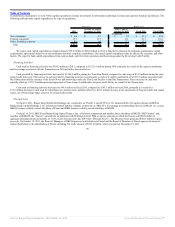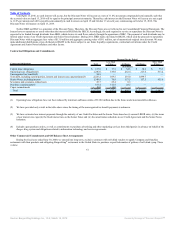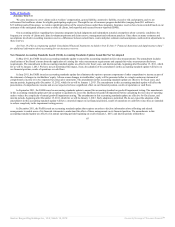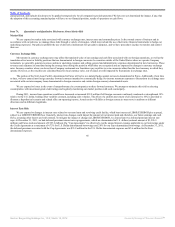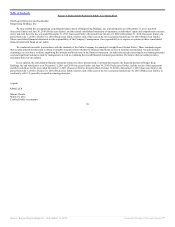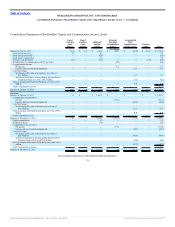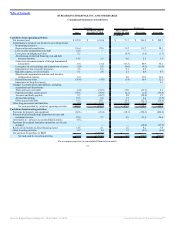Burger King 2011 Annual Report Download - page 67
Download and view the complete annual report
Please find page 67 of the 2011 Burger King annual report below. You can navigate through the pages in the report by either clicking on the pages listed below, or by using the keyword search tool below to find specific information within the annual report.
Table of Contents
annual periods, and includes disclosures to be applied retrospectively for all comparative periods presented. We have not yet determined the impact, if any, that
the adoption of this accounting standard update will have on our financial position, results of operations or cash flows.
Item 7A. Quantitative and Qualitative Disclosures About Market Risk
Market Risk
We are exposed to market risks associated with currency exchange rates, interest rates and commodity prices. In the normal course of business and in
accordance with our policies, we manage these risks through a variety of strategies, which may include the use of derivative financial instruments to hedge our
underlying exposures. Our policies prohibit the use of derivative instruments for speculative purposes, and we have procedures in place to monitor and control
their use.
Currency Exchange Risk
Movements in currency exchange rates may affect the translated value of our earnings and cash flow associated with our foreign operations, as well as the
translation of net asset or liability positions that are denominated in foreign currencies. In countries outside of the United States where we operate Company
restaurants, we generally generate revenues and incur operating expenses and selling, general and administrative expenses denominated in local currencies. These
revenues and expenses are translated using the average rates during the period in which they are recognized and are impacted by changes in currency exchange
rates. In many countries where we do not have Company restaurants our franchisees pay royalties to us in currencies other than the local currency in which they
operate. However, as the royalties are calculated based on local currency sales, our revenues are still impacted by fluctuations in exchange rates.
The portion of the Term Loan Facility denominated in Euros will serve as a natural hedge against net assets denominated in Euros. Additionally, from time
to time, we have entered into foreign currency forward contracts intended to economically hedge our income statement exposure to fluctuations in exchange rates
associated with our intercompany loans denominated in foreign currencies and certain foreign currency-denominated assets.
We are exposed to losses in the event of nonperformance by counterparties on these forward contracts. We attempt to minimize this risk by selecting
counterparties with investment grade credit ratings and regularly monitoring our market position with each counterparty.
During 2011, income from operations would have decreased or increased $18.9 million if all foreign currencies uniformly weakened or strengthened 10%
relative to the U.S. dollar, holding other variables constant, including sales volumes. The effect of a uniform movement of all currencies by 10% is provided to
illustrate a hypothetical scenario and related effect on operating income. Actual results will differ as foreign currencies may move in uniform or different
directions and in different magnitudes.
Interest Rate Risk
We are exposed to changes in interest rates related to our term loans and revolving credit facility, which bear interest at LIBOR/EURIBOR plus a spread,
subject to a LIBOR/EURIBOR floor. Generally, interest rate changes could impact the amount of our interest paid and, therefore, our future earnings and cash
flows, assuming other factors are held constant. To mitigate the impact of changes in LIBOR/EURIBOR, we entered into two deferred premium interest rate
caps. At December 31, 2011, we had deferred premium interest rate cap agreements, which are denominated in U.S. dollars (notional amount of $1,526.9
million) and Euros (notional amount of €193.6 million) (the “Cap Agreements”) to effectively cap the annual interest expense applicable to our borrowings under
the Credit Agreement at a maximum of 4.75% for U.S. Dollar denominated borrowings and 5.0% for our Euro-denominated borrowings. At December 31, 2011,
the deferred premium associated with the Cap Agreements was $35.8 million for the U.S. Dollar denominated exposure and €5.6 million for the Euro
denominated exposure.
66
Source: Burger King Holdings Inc, 10-K, March 14, 2012 Powered by Morningstar® Document Research℠






